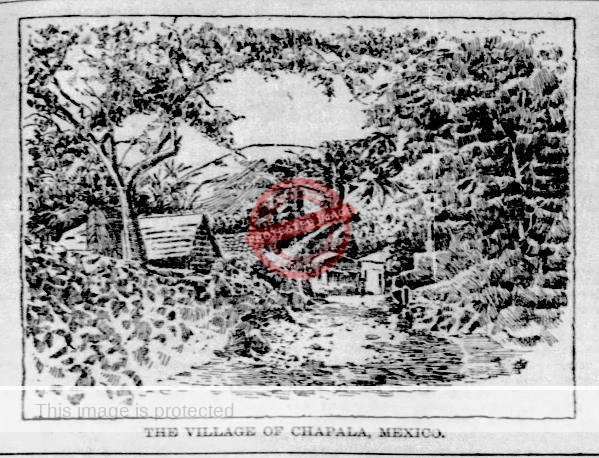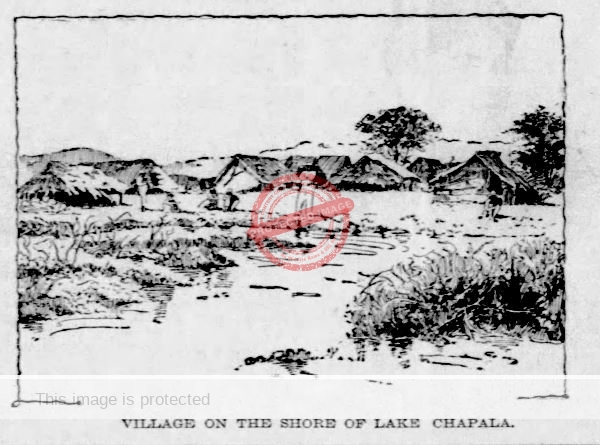What was Italian Count Giuseppe Antona doing at Lake Chapala in 1895? Shooting as many teal ducks as possible! And he wrote all about it for The Detroit Free Press.
Who was Giuseppe Antona?
Count Alessandro Giuseppe (sometimes Guiseppe) Valerio Antona was born in Asli, Italy, on 10 May 1865 and died in Detroit, Michigan, on 27 January 1931. According to a short piece about him in The Detroit Free Press shortly after he moved to the US in 1893, he had previously worked for the Italian government, and came from an old Piedmont family.
His grandfather was “the Count of Casale and Montebello until the Austrian domination in Italy obliterated the title with many others in Piedmont.” Following the death of his elder brother in February 1894, Giuseppe theoretically succeeded to the “earldom and estates of Barraggio, including one of the largest and most valuable vineyard tracts in all Piedmont,” in the event that his family’s title was ever restored by King Umberto I, as was widely expected to happen at the time. Unfortunately for Antona, the King was assassinated in 1900.
In April 1894 a Mexican newspaper reported that “Sra Annetta Josefa Valerio-Antona and Sr Alessandro Giuseppe Valerio-Antona, Italian writers who have lived in US for some time” were staying at the Hotel Humboldt for a couple of months, with plans to write articles for US news outlets and a book about Mexico. This report was not entirely accurate. Annetta Josefa Halliday (1866-1949) was American, not Italian, and went to Mexico as a special correspondent for the Chicago Times. Giuseppe did not marry Annetta until 26 June that year; the newlyweds received a cable of congratulations from President Porfirio Díaz and his wife.
Despite being offered a post as Secretary to the Italian Royal Legation in Cairo, Egypt, Antona chose to remain in Detroit, and do some writing alongside investing in real estate, construction, a chemical business and the wine trade. Annetta continued her established career in writing and lecturing. Less than a month after their marriage, Annetta gave a presentation on “Mexico, the Egypt of the New World” at the Chateau Frontenac in Quebec City, Canada. Annetta also taught history and art at the Ganopel School of Musical Art. She was also reportedly working on a book about Mexico, titled The Florence of Mexico, based on her knowledge of Mexico and Mexican customs. Whether by coincidence or not, this was precisely the same title as a work by Mexican diplomat Eduardo A Gibbon published a few years earlier. She also published articles in Town Topics, Smart Set, Munsey’s, McClure’s, Scribner’s, Collier’s, Good Housekeeping, Outing and the New York Tribune.
The Antonas’ only child, Janice, was born in Michigan on 15 June 1901. Eleven years later, in 1912, Detroit society was shocked to the core when the “Count and Countess” were arrested in relation to the sudden death of their housekeeper, and were held behind bars for several days. According to press reports, their housekeeper, Miss Lizzie Fleming died at the age of 63 on 4 July after a short illness, and her body was cremated the following day. Suspicions were arisen because a few days prior to her death, Fleming made a will leaving virtually everything to Mrs. Antona. Her relatives in Ohio, who did not learn about her death until a few weeks later, claimed that Fleming had often expressed a horror of cremation and had already purchased a cemetery lot for her burial, and demanded an investigation.
What did Giuseppe Antona write about Chapala?
Antona opens his article with an exaggeratedly poetic description of Lake Chapala, setting the scene for the spring morning when he set off with three friends (one of them the son of the American consul) to shoot waterbirds at the lake. After taking the train from Guadalajara to Atequiza, the four gun-toting sportsmen’s plans to take the stage coach to Chapala were thwarted—”rendered impossible by the conductor’s illness”—so they “procured horses with some difficulty for ourselves and one extra for provisions and ammunition,” before riding south to the lake.
Antona’s article is illustrated by two unsigned sketches, which may well be the author’s own work: one of the village of Chapala, and the other of an unidentified tiny lakeshore village.
After riding through “Rancho del Mirador” and three small haciendas—San Nicolas, Labor and Buena Vista— the group approached Chapala, entering the village through a “rustic wood gate” designed to keep village livestock (and people) off the adjoining hacienda land. (Mexican Herald correspondent Owen Wallace Gillpatrick, who rode from Atequiza to the lake about three years later, claimed to have ridden through about a dozen ranches, separated by gates which were opened “at the rate of a centavo a gate, which is cheap as gates go.”)
In the 1890s the village of Chapala was tightly sandwiched between the Hacienda del Cuije (to the west and north) and the Hacienda de la Labor (to the east). As Antonio de Alba wrote decades later in Chapala, the northern limit of the village until some years into the twentieth century was approximately along the line followed by calle Degollado. It was several years after Antona’s visit before the local haciendas lost their territorial power, and Chapala had room to expand.
Antona’s visit predated the opening of the Hotel Arzapalo in 1898, so where did he stay? Arriving in Chapala, Antona and his friends “dismounted at the Inn of the ‘Nueva Purissima,’ [which] was more suited to be called a stable than anything else.” According to Antona, the rooms had no windows, a description which does not match the small inn where Eduardo Gibbon had stayed a few years earlier. Antona’s hostelry was the (no longer extant) building called “Mesón de la Purísima,” located where the Plaza Chapala Hotel (Avenida Madero #232) is today.

Giuseppe Antona (?). The Detroit Free Press, 1895.
Antona and his companions walked down to the beach, where:
The view was most fascinating: with rolling hills, steep mountains, the perfect sky, and the villas scattered here and there; one called Monte Carlo was kept by an English man named Crow[e] and nestled among the rocks like a little fortress.”
Antona’s mention of “villas” (plural), the Montecarlo, and of its then owner, Septimus Crowe, all dovetail perfectly with my own view of when and how Chapala first began its courtship with tourism. Chapala’s development certainly began some years before 1895, the date often used (even today) in some Spanish-language accounts.
The beach reminded Antona of his native land: “The smooth, sandy stretch of beach touched by the fringe of the waves, recalled the lake regions of sunny Italy.” But it was not tourism that brought Antona and his friends to Chapala, it was the local wildlife, including:
the wild teal duck, which made their homes in the tangle of matted vegetation on the shores, and render Chapala a veritable paradise.”
After bathing in the lake, they:
procured a native boat and an Indian who served both as a steersman and oarsman, and embarked just before sunset well provided with ammunition and Parker guns, our zest for sport heightened by the tract of morass visible in the distance… which our greed told us could not but abound with prey.
Our craft, made from a hollowed tree trunk, had for oars and rudder a single pole, such as might be called a slender flag-staff in the states, and used for such on national holidays, and which our Indian boatman and guide, Feliciano, maneuvered much like a laundryman attempting to fill a receptacle of soiled clothes.

Giuseppe Antona (?). The Detroit Free Press, 1895.
By moonlight, with the stars twinkling overhead, the men:
gradually and cautiously approached the feeding grounds, and leaving the smallest of wakes behind us, slid gently through the reeds and grasses and anchored behind some great logs near a mud bank.”
As hundreds and hundreds of ducks started feeding in front of them, the men opened fire:
Out of the reeds and sedge flew the terrified fowl, hundreds of wounded concealing themselves in the rushes, others half-swimming, half-wading away in their fright, the loud flapping of wings of the thousands in flight seeming like distant thunder, while dull thuds and loud splashes made known where our shots had told upon water and upon land.”
After waiting a few minutes—and as surviving ducks returned to feed—the men opened fire again… and again:
Each man emptied his barrels as quickly as possible into the black clouds, loading up again every three minutes as long as ammunition lasted.”
When the dawn light came up, the men collected “200 ducks, or 50 apiece, all blue-winged teal.” The ducks were taken to shore, and a Mexican boy hired to carry them back to the village, while the men rowed their boat back.
In addition to his article about Lake Chapala, Giuseppe Altona also published pieces about Alaska and America-Russia relations.
Lake Chapala: A Postcard History uses reproductions of more than 150 vintage postcards to tell the incredible story of how Lake Chapala, at the end of the nineteenth century, became a significant international tourist destination. Most chapters of If Walls Could Talk: Chapala’s Historic Buildings and Their Former Occupants (also published in Spanish as Si las paredes hablaran: Edificios históricos de Chapala y sus antiguos ocupantes) relate to the early tourist history of Chapala.
Sources
- Guiseppe [Giuseppe] Antona. 1895. “Shooting Teal Duck at Lake Chapala.” The Detroit Free Press, 3 March 1895, 11.
- Antonio de Alba. 1954. Chapala. Guadalajara: Banco Industrial de Jalisco.
- The Detroit Free Press: 10 Dec 1893, 23; 3 Jun 1894, 9.
- El siglo diez y nueve: 17 April 1894, 17.
- Eduardo A Gibbon. 1893. Guadalajara, (La Florencia Mexicana). El salto de Juanacatlán y El Mar Chapálico. 1992 reprint, Guadalajara: Presidencia Municipal de Guadalajara.
- The Omaha Evening Bee: 26 Mar 1895, 1.
- Muncie Evening Press: 31 Jul 1912, 2.
- Quebec Morning Chronicle: 4 July 1894, 2.
- The American: 29 Mar 1895, 1.
Comments, corrections and additional material are welcome, whether via the comments feature or email.
Tony Burton’s books include “Lake Chapala: A Postcard History” (2022), “Foreign Footprints in Ajijic” (2022), “If Walls Could Talk: Chapala’s historic buildings and their former occupants” (2020), (available in translation as “Si Las Paredes Hablaran”), “Mexican Kaleidoscope” (2016), and “Lake Chapala Through the Ages” (2008).
Just wonderful history–thanks